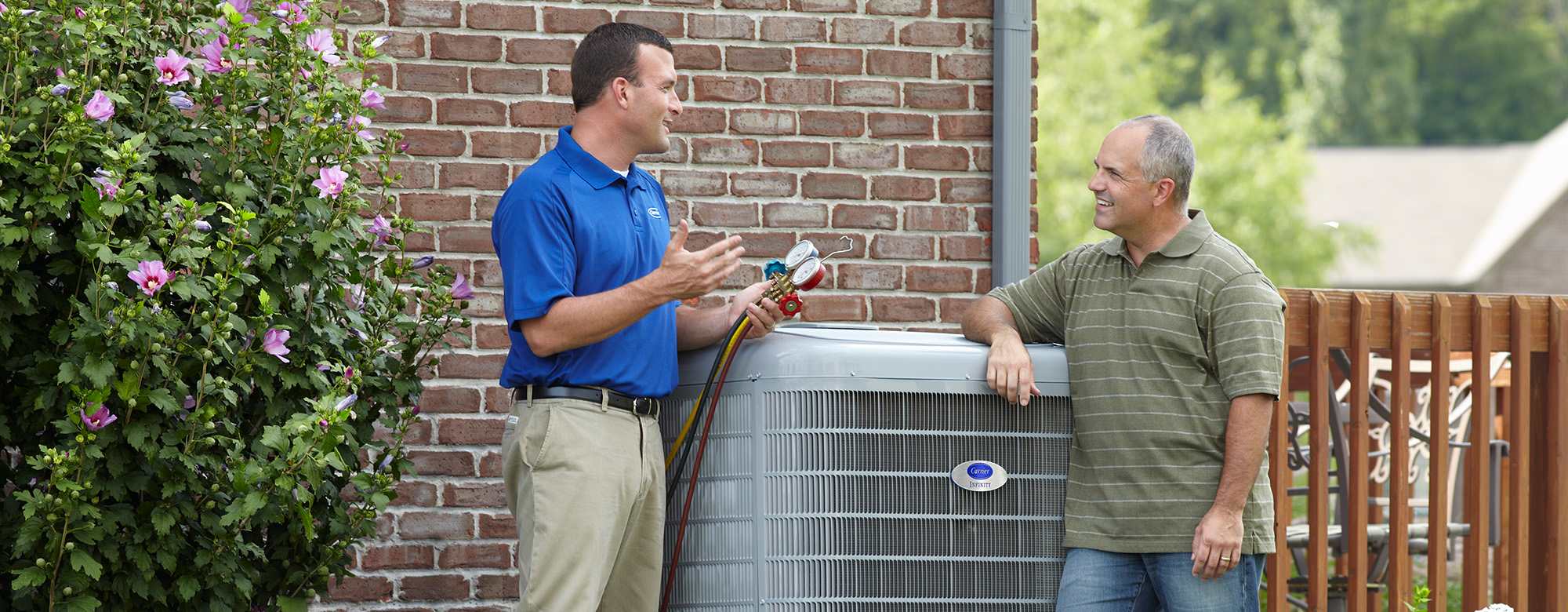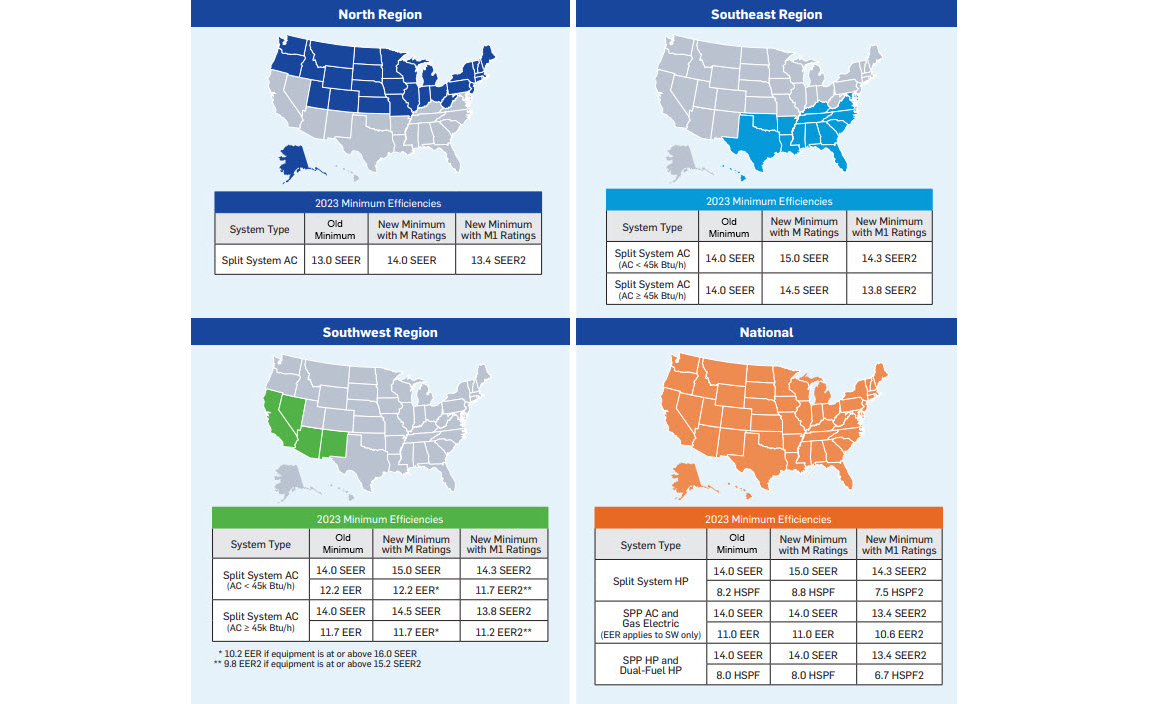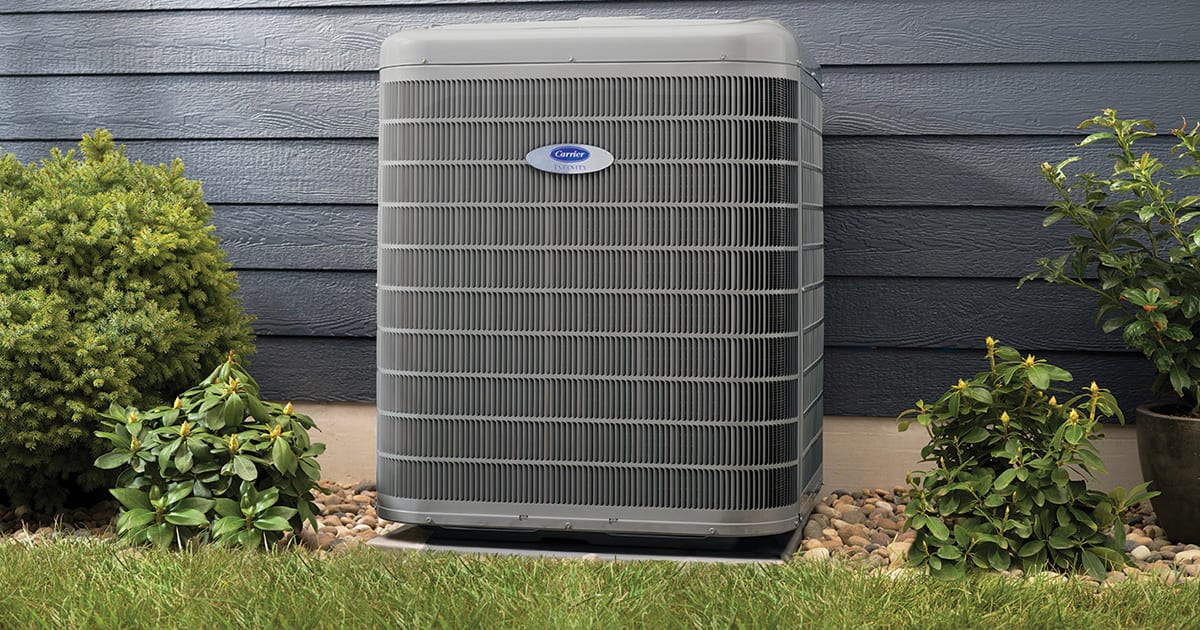Heat Pump Efficiency

When it comes to heating and cooling your home, heat pumps offer a highly efficient alternative to traditional HVAC systems. Unlike furnaces and air conditioners that generate heat or cold air, heat pumps transfer heat, which requires significantly less energy and can lead to significant savings on your heating and cooling bill, depending on local utility rates and home size.
Below is a comprehensive guide to understanding heat pump efficiency—what it means, how it’s measured, and how to choose the most efficient system for your home.
Are Heat Pumps More Efficient Than Other HVAC Systems?
Traditional HVAC systems like furnaces and central air conditioners typically operate by generating heat through combustion or electrical resistance (in the case of furnaces) and by compressing refrigerants to cool (in the case of air conditioners). These systems generally have an efficiency rating of around 80–98% for gas furnaces (meaning 80–98 cents of every dollar spent goes to actual heating) and a SEER2 rating of 13–20 for air conditioners, depending on the model. In contrast, heat pumps move heat rather than generate it, allowing them to operate with efficiencies of 300% to 500% or more1, depending on conditions and model type. Learn more about what is a heat pump.
Because they can both heat and cool a home, heat pumps offer a year-round, all-in-one solution with better overall energy performance. They often outperform even high-efficiency furnaces and air conditioners in terms of cost savings and environmental impact, and many qualify for heat pump tax credits. Even in colder regions, newer cold climate heat pumps are closing the performance gap thanks to advanced inverter technology and variable-speed compressors, making them a viable, energy-smart upgrade over traditional systems.
Defining Important Efficiency Terms: SEER2, HSPF2, EER & COP
Heat pump systems act as both cooling and heating systems for your home. Because of this, heat pump efficiency ratings are published separately for heating and cooling functions. These efficiency ratings are calculated using different metrics.
The most common heat pump efficiency ratings for residential air-source, heat pumps are:
Geothermal heat pumps raise the efficiency stakes and can deliver even higher energy efficiencies than typical air-source models. Making an “apples to apples” comparison between geothermal and air-source systems is a little tricky because geothermal comfort systems use a slightly different method of measuring energy efficiency levels during heating and cooling modes. The efficiency ratings for geothermal heat pumps are:
- Energy Efficiency Ratio 2 (EER2)
- Coefficient of Performance (COP)
SEER2 stands for Seasonal Energy Efficiency Rating 2. It is a rating used to measure a heat pump’s cooling efficiency. It is a standard used to compare the efficiencies of different air conditioner or heat pump units. SEER2 measures the total heat removed from the conditioned space (in Btu) during a typical cooling season divided by the total electrical energy consumed (in watt-hours) during that season. A higher SEER2 rating means greater cooling efficiency.
When looking at heat pumps, higher SEER2 ratings translate into more cost savings over the life of the unit. If you have an older unit with a SEER rating of 8, for example, upgrading to a unit with a SEER2 rating of 15.3 could save you roughly 50% on your energy bill.
How is SEER2 Calculated?
SEER2 is calculated using the total amount of heat removed from the home during the cooling season, divided by the total number of hours the system operated during the same time frame. The calculation takes into account varying temperature conditions throughout the cooling season.
What are the Minimum SEER2 Requirements in 2025?
Minimum SEER2 efficiency: The Department of Energy established 14.3 SEER2 as the minimum allowable cooling efficiency for residential, air-source, split-system heat pumps, as of January 1, 2023.
High-efficiency heat pumps: Generally speaking, models rated at 17 SEER2 and above should be considered highly efficient heat pumps. Some of the highest efficiency air-source heat pumps are rated at up to 22 SEER2.
HSPF2 stands for Heating Seasonal Performance Factor 2. It is a rating used to measure a heat pump’s heating efficiency. Much like miles-per-gallon for your car, a higher HSPF2 number equals a higher efficiency heat pump.
How is HSPF2 Calculated?
HSPF2 is calculated using the total amount of heat provided during the heating season compared to the amount of electricity used by the heat pump during the same time frame, taking varying outdoor temperature conditions into account.
What are the Minimum HSPF2 Requirements in 2025?
Minimum HSPF2 efficiency: The Department of Energy has established 7.5 HSPF2 as the minimum efficiency for residential, air-source, split-system heat pumps.
High-efficiency heat pumps: While some of the highest-performing air-source heat pumps are rated at 10.5 HSPF2, anything about 9 HSPF2 should be considered to be a high-efficiency model.
EER2 stands for Energy Efficiency Ratio 2. It is a rating used to measure a geothermal heat pump’s cooling efficiency. It is similar to SEER2, but measured at a specific temperature instead of varying temperatures throughout the cooling season.
How is EER2 Calculated?
EER2 uses a fixed temperature to calculate the rating – and because the heat source (ground or water) temperature doesn’t fluctuate as much as outdoor air temperatures, it’s a truer measure of the system’s actual capabilities.
What are the Minimum EER2 Requirements in 2025?
Minimum efficiencies: The Department of Energy has established minimum efficiencies of 16.1 EER cooling for closed loop, water-to-water geothermal heat pumps.
High-efficiency geothermal systems: Geothermal systems come in a variety of options, but generally, high performing models can achieve energy efficiency ratings 30.0 EER or higher cooling efficiencies.
COP stands for Coefficient of Performance. It is a rating used to measure a geothermal heat pump’s heating efficiency. It is similar to HSPF2, but measured at a specific temperature instead of varying temperatures throughout the heating season.
How is COP Calculated?
Similar to EER, COP uses a fixed temperature to calculate the rating – and because the heat source (ground or water) temperature doesn’t fluctuate as much as outdoor air temperatures, it’s a truer measure of the system’s actual capabilities.
What are the Minimum COP Requirements in 2025?
Minimum efficiencies: The Department of Energy has established minimum efficiencies of 3.1 COP heating for closed loop, water-to-water geothermal heat pumps.
High-efficiency geothermal systems: Geothermal systems come in a variety of options, but generally, high performing models can achieve energy efficiency ratings of 4.5 COP or higher heating efficiencies.
Heat Pump Efficiency Requirements by Region
The following chart displays the varying minimum efficiency requirements for split system air conditioners based on your geographical location. This HSPF2, EER2, and SEER2 chart shows what heat pump efficiency values are relevant to you. However, it is important to note that for heat pumps, the Department of Energy has established a uniform national minimum efficiency standard.

North Region
In northern regions, where cold temperatures challenge HVAC performance, heat pumps must meet stricter efficiency standards. Previously, the minimum allowed efficiency was 13 SEER, but newer standards increased that to 14 SEER with the “M” rating, and now to 13.4 SEER2 under the updated M1 rating system, which more accurately reflects real-world performance. These higher-efficiency requirements ensure heat pumps in cold climates deliver reliable heating while maintaining energy savings.
Southeast Region
In the Southeast, where higher cooling demands are common, efficiency standards for heat pumps have progressively increased. The old minimum was 14 SEER, followed by 15.0 SEER or 14.5 SEER under the “M” ratings, depending on the system’s BTU/h capacity. The latest M1 standards require a minimum of 14.3 SEER2 or 13.8 SEER2, again based on BTU/h, ensuring systems are optimized for the region’s hot and humid climate.Southwest Region
In the Southwest, where high temperatures and intense cooling loads are common, both SEER and EER standards have been key benchmarks. The previous minimum was 14 SEER and 12.2 EER, then increased under the “M” ratings to 15.0 SEER or 14.5 SEER and 12.2 EER or 11.7 EER, respectively, depending on BTU/h. The latest M1 efficiency standards require 14.3 SEER2 or 13.8 SEER2 and 11.7 EER2 or 11.2 EER2 depending on BTU/h, ensuring heat pumps remain effective and energy-efficient in extreme heat.Nationwide Minimum
Nationwide minimum efficiency standards for HVAC systems have also evolved to ensure greater energy savings across all regions. For split system heat pumps, the new minimum is 14.3 SEER2 and 7.5 HSPF2, reflecting improved cooling and heating performance. Packaged air conditioning and gas-electric systems now require 13.4 SEER2 and 10.6 EER2, while packaged heat pumps and dual-fuel systems must meet a minimum of 13.4 SEER2 and 6.7 HSPF2, ensuring better efficiency in both heating and cooling modes.Factors that Influence Heat Pump Efficiency
The decision to buy a heat pump, and decisions about which heat pump to purchase, will be influenced by a number of factors. While there is no “right” answer, there are plenty of options, and your individual priorities in each category will help you choose the system that is best for your family and your budget.
Type of Energy Source
A heat pump is considered to be energy efficient because it heats and cools an area by moving heat rather than converting it from another fuel source. According to the Department of Energy, heat pumps can reduce electricity usage by 50% compared to electric resistance heating such as furnaces and baseboard heaters.*
Different types of heat pumps can draw heating energy from different sources. Each type has its own set of advantages, and all can be an effective solution, depending upon your needs, the design of the home, and your budget. Talk to your local Carrier dealer about the type of heat pump installation that makes the most sense for your home.
- Air-source: An air-source heat pump looks like a typical central air conditioning unit. It is powered by electricity and transfers heat energy from outdoor air to heat your home during the heating season. Split-system, air-source heat pumps include a unit inside the home and a unit outside the home. They generally cost less than geothermal systems, especially considering installation costs, but are typically not as energy efficient. Packaged air-source heat pumps are available as well with the entire system in one cabinet.
- Mini-split ductless: Mini-split ductless heat pumps are powered by electricity and also draw heat from outdoor air to heat your space. Mini-split systems are well-suited for providing heat in one space, because the indoor unit is designed to heat the area in which it is installed. However, there are systems that can accommodate multiple indoor units with one outdoor unit and can be used to provide comfort for a small home.
- Geothermal ground-source: These models pull heating energy from the ground to transfer heat into and out of your home. Geothermal, ground-source heat pumps can have higher efficiency ratings than air-source models, but can be more expensive due to installation costs for the required underground loop system.
- Geothermal water-source: These models pull heating energy from a water source such as a lake, pond, or underground aquifer. Geothermal, water-source heat pumps can be more energy efficient than air-source models, but more expensive to install. They also require an available water source near your home.
*See https://www.energy.gov/energysaver/heat-and-cool/heat-pump-systems.
Ductwork in the Home
Most new homes in the U.S. are built to accommodate ducted, air-source heat pumps. If you are replacing an existing system, chances are you’ll probably want to stick with a similar type of ducted system. However, a ductless mini-split system is another option when ductwork is either unavailable, in poor repair, or non-existent.
Ductless, air-source models are gaining popularity for heating or cooling room additions, older homes or spaces that don’t have existing ductwork, or rooms where the ducted system struggles to maintain comfort. Installation is fairly easy because no ductwork is required – the indoor and outdoor units are simply connected by a small-diameter copper refrigerant line and wiring for power to the indoor unit.
Regional Climate
For year-round heating and cooling comfort, heat pumps work great in areas of the country with moderate temperatures. This is especially critical during the heating season. Once the outdoor temperature goes below 25⁰ - 30⁰ F, a heat pump can continue to provide heat. However, it will use more electricity to do so, which means higher utility bills. This is because there simply isn’t as much heating energy available as the outdoor temperature drops and the system will work longer to achieve the same indoor temperature. That’s why many air-source heat pump systems are installed with a supplemental heat sources.
On the cooling side, the exterior temperature will affect heat pump efficiency and performance in the same way it would affect central air conditioning. Both systems are installed to provide adequate cooling capacity to your home at a specified outdoor temperature that makes sense in your area of the country (based on average high temperatures during the cooling season). And, both AC systems and heat pumps will work harder as temperatures rise outside.
Heat pumps can also be a good option for use in humid climates. Humidity inside your home can actually make you feel less comfortable, causing a natural response to turn down the temperature for additional cooling (and higher electric bills). High efficiency heat pumps generally dehumidify better than standard models because they are designed to run nearly continuously and at different cooling output levels (or different speeds). Because the cooling process helps remove humidity from indoor air, this means the higher efficiency heat pump spends more time dehumidifying indoor air (while consuming less energy).
Sizing
Heat pump units are “sized” according to the heating and cooling needs of your home. While a larger home often requires a larger capacity heat pump, there are many factors involved, so sizing should be left to a qualified HVAC technician.
Sizing is an important factor that not only affects your comfort, but directly impacts the efficiency of the system as well. If a heat pump is undersized, it will likely be incapable of effectively heating or cooling a space. It may run virtually non-stop trying to meet the temperature you set on the thermostat. The result will be a higher electric bill and an uncomfortable home as well.
A unit that is oversized will sacrifice comfort and efficiency as well. An oversized unit may start running, heat or cool the home very quickly, then turn off until the home needs heating or cooling again. This constant on-and-off operation is hard on the system’s components, in addition to being very inefficient. A heat pump is most efficient when the temperature is maintained evenly, without the big ups and downs. So, having a unit that is oversized could result in inefficiencies and shorten the unit’s lifespan.
Home Insulation
- Weather stripping doors
- Caulking windows
- Insulating and sealing ductwork
- Insulating walls in the home
- Insulating attic spaces
TAXES AND REBATES FOR HIGH EFFICIENCY HEAT PUMPS
Higher efficiency heat pumps will cost more than mid- or standard-efficiency models. That is due in large part to the additional technology needed to increase efficiency. At the same time, this technology can also provide additional comfort benefits.
While it’s true that a higher efficiency heat pump can help to save money on your monthly heating and cooling bills, at times there may also be tax credits or local rebates available for some higher efficiency models. Some of the rebates come from local utilities for heat pump SEER2 and HSPF2 ratings, so check with the power company in your area see what’s available. For your convenience, follow the link to our HVAC Rebates page to see if there are rebates available in your area, and which models may qualify.
Questions About Heat Pump Efficiency?
Our vast network of Carrier heating and air dealers can help answer all of your heat pump and HVAC questions, including clarifying the differences between the SEER and SEER2 efficiency ratings. Contact your local Carrier dealer today!

Frequently Asked Questions On Heat Pump Efficiency
- Get information about the cost of a heat pump
- Learn about heat pump service
- Heat Pumps: A Sustainable Comfort Solution
- In need of heat pump repair?
- How much will a heat pump increase my electric bill?
- Learn if you need a 3 ton heat pump

